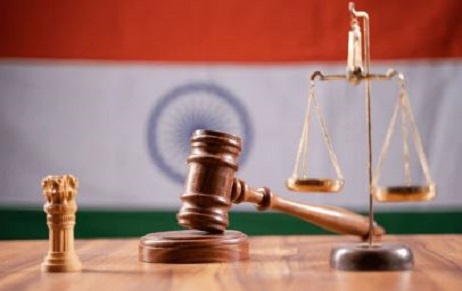ABSTRACT The project employs doctrinal research methods, i.e. secondary research which involves writing on basis…
Trademark Infringement: Officer’s Choice Vs. Fauji
About Officer’s Choice
Officer’s Choice commonly known as ‘OC’, is an Indian whisky brand which is owned by Allied Blenders & Distillers (ABD). It is considered to be one of the largest spirit brands in the world. In 2015 Officer’s Choice overtook Smirnoff vodka to become the world’s largest selling spirit brand. In the year 2014, this Brand sold 28.4 million cases which is comparatively higher than any other spirit brand in the world. When other Indian Whiskey branks are made from molasses, OC is made from grain.
Officer’s Choice mainly targeted consumers are the daily wagers. To broaden its consumer circle ABD introduced premium versions of Officer’s Choice namely Officer’s Choice Blue, and Officer’s Choice Black. The black variety is a blend prepared using Indian grain spirits and rare Scotch malts that have been aged in charred oak barrels.
In 2013, OC for the first time became the largest selling whisky in the world by overtaking Johnnie Walker. It sold 23.8 million cases in 2013 which was 15% of the liquor market share of India. As per 2013 sales, OC was the third largest selling spirit brand in the world, while Smirnoff vodka had topped the list. OC sold 28.3 million cases in 2014 and overtook Smirnoff vodka as the largest selling spirit brand in the world. In the year of 2013, the retail sale of Officer’s Choice exceeded $1.25 bn. OC became the 3rd Indian spirit brand to cross the $1 billion mark, the other 2 being McDowell’s No. 1 and Royal Stag.
Officer’s Choice Vs Collectors Choice (M/S ALLIED BLENDERS & DISTILLERS PVT. LTD. Vs SHREE NATH HERITAGE LIQUOR PVT. LTD.
Here the plaintiff was the rightful owner of the trademark ‘Officer’s Choice’. The mark was in use by the plaintiff since 1988 and the plaintiff got this trademark registered in 2007. In 2013, it came under the knowledge of the Plaintiff that the Defendant is selling whiskey under the trademark named ‘Collector’s Choice’. To restrain the Defendant from using it the Plaintiff filed a permanent injunction. The Hon’bleCourt upheld the plaintiff’s arguments and extended the ex-parte interim injunction till final decision. The Court in this case emphasized on consumer psychology and associative thinking in order to come to the conclusion that a ‘Collector’ could be confused with an ‘Officer’.
Plaintiffs arguments – The defendant was using the mark “Collector’s Choice” for its own whiskey and had filed for registration in 2011. As a matter of fact, the Defendant was aware of the Plaintiff’s mark as it had served reply to it in one of the objections. Moreover, by using the mark ‘Collector’s Choice’ it clear that the defendant admitted that a Collector is an Officer and it wants to play on the goodwill of the Plaintiff. Hence the plaintiff argued that the defendant dishonestly used a mark similar to its mark. Plaintiff argued that its consumers will associate the Defendant’s product as the product from the same house as Plaintiff, which is against the practice of fair and transparent trade.
Defendant’s arguments – The defendant contended that the use of the word ‘Choice’ was by the Defendant is not similar to the Plaintiff’sand as the plaintiff did not have any monopoly over the word ‘Choice’. Since ‘Collector’ and ‘Officer’ are not phonetically or visually similar and the only common word is ‘Choice’, the marks are not deceptively similar.
Judgement – The court supported the contentions made by the plaintiff and held that ‘Officer’s Choice’ and ‘Collector’s Choice’ might create confusion among consumers. The Court relied upon the trademark case ‘Old Monk’ v. ‘Told Mom’, where it was held that the two marks were deceptively similar. If we look at the consumers consuming Old Monk, the fact that a large number of consumers are daily labourers and are still illiterate and the peculiar nature of the alcohol trade, the phonetic similarity between these two marks was likely to cause confusion among consumers.
In addition to this case, Justice Endlaw’s independent research on consumer psychology and associative thinking contributed significantly to conclude that ‘Officer’ and ‘Collector’ are deceptively similar and likely to confuse the target consumers.
(Also, for reference we can look at the case of Allied Benders and Distilleries Pvt. Ltd. v. M/s. John Distillers Ltd. &Ors. where the Defendant had used the name ‘Original Choice’)
Officer’s Choice Vs. Fauji (M/S ALLIED BLENDERS AND DISTILLERS PVT. LTD. Vs GOVIND YADAV & ANR) –
Allied Blenders moved to the High Court to restrain the defendants from using the mark ‘Fauji’ for being conceptually and deceptively similar to its own brand. The Plaintiff contended that its trademark ‘Officer’s Choice’ was adopted by him in 1988, got it registered in 2007 and it even has been registered its label under the Copyright Act, 1957. The Plaintiff contentions were that the rationale behind its trademark ‘Officer’s Choice’ and the Defendants’ trademark was identical, as ‘Fauji’ was a commonly used Hindi phrase for ‘Military Officer’.Moreover, the upward slanting stylized font, as well as the colour combination of the two marks, was very much identical with each other. Therefore, the Plaintiff argued that since both the products were in the same business domain and were using their respective marks for products of identical description i.e. whisky, the chances of getting confused amongst the consumers was very high. Rejecting all the contentions by the Plaintiff, the Court concluded that there was “no resemblance or similarity” between plaintiff’s trademark ‘Officer’s Choice’ and the defendants’ mark ‘Fauji’.The Court observed that not only the two marks were phonetically different but the literal meaning of the two words was also different.“The word “Officer” identifies “a person in power” on the other hand “Fauji” means a soldier who is not a military officer. The Plaintiff’s argument that “Fauji” means a Military Officer is not correct and got rejected. It also rejected the submission that the Defendants used a font identical to that of the Plaintiff’s product. The Court further recorded that while the epaulette on the defendants’ product depicts “Three Stars” of a soldier, the epaulette on that of the plaintiff’s brand is that of an officer. It thus concluded that there was no similarity between the marks and labels of both the parties and that there was no likelihood of a consumer being confused between the products.
Conclusion
The work of the Trademark is to avoid consumer confusion and consumer deception; therefore, the main characteristic of a Trademark is one of the most important factors. This very characteristic was focused upon in the case of Officer’s Choice Vs. Fauji, where the Court mentioned the consumer psychology that gets affected if the trademark is not distinctive enough. Similarly, in the second case if we see the consumer section for both the products are same such as daily labourers, but the name of this products is totally different in nature as one is in English and the other is in Hindi having a different meaning. Although the target audience would be the same, however, they all will be able to easily differentiate between the two brands and no confusion will be created with regard to the logo and shape of the bottle(may also regard as trade dress).
Author: Rohan Dalbehera, Intern at Khurana & Khurana, Advocates and IP Attorneys. In case of any queries please contact/write back to us at pratistha@iiprd.com.



